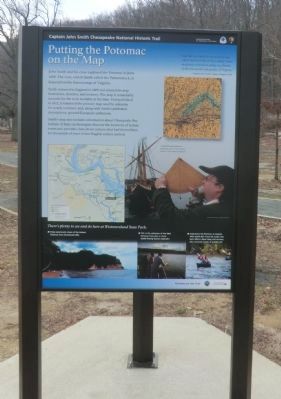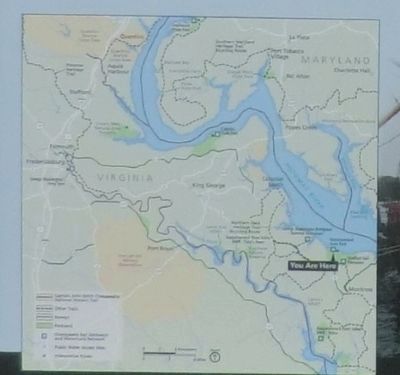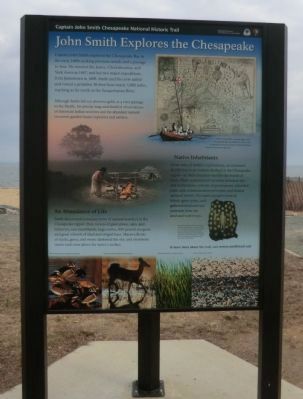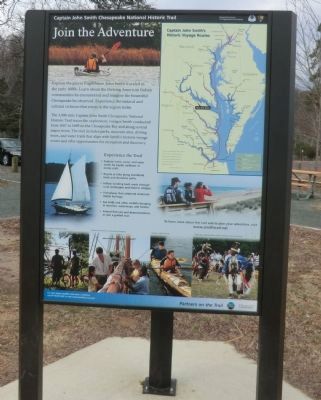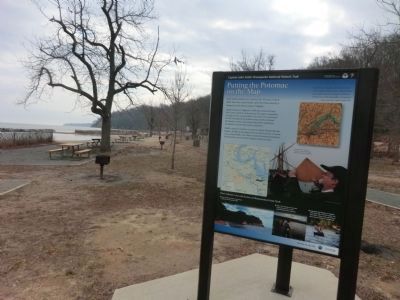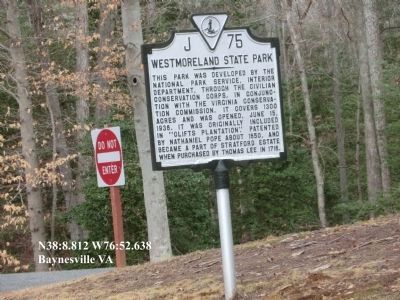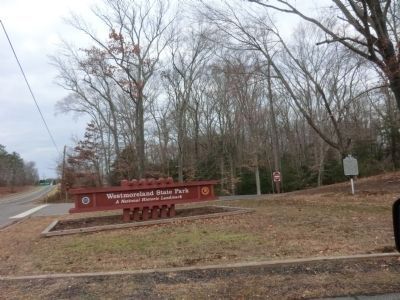Montross in Westmoreland County, Virginia — The American South (Mid-Atlantic)
Putting the Potomac on the Map
Captain John Smith Chesapeake National Historic Trail
(panel 1)
Putting the Potomac on the Map
John Smith and his crews explored the Potomac in June 1608. The river, which Smith called the Patawomeck, is featured on his famous map of Virginia.
Smith returned to England in 1609 and created his map from notes, sketches, and memory. The map is remarkably accurate for the tools available at the time. First published in 1612, it remained the primary map used by colonists for nearly a century and, along with Smith’s published descriptions, spurred European settlement.
Smith’s map also includes information about Chesapeake Bay Indians. It helps archeologists discover the locations of Indian towns and provides clues about culture that had thrived here for thousands of years before English settlers arrived.
“And this is as much as my memory can call to mind worthy of note, which I have purposely collected to satisfy my friends of the true worth and quality of Virginia.” —Captain John Smith, A Map of Virginia, 1612
(caption)
(lower right) A reenactor demonstrates a quadrant, a type of instrument used by 17th century explorers.
(bottom) There’s plenty to see and do here at Westmoreland State Park: • Enjoy spectacular views of the historic Potomac from Horsehead Cliffs. • Fish in the saltwater of the tidal Potomac from pier or shore. (Valid fishing license required) • Experience the Potomac as Captain John Smith did—from the water. The park offers a boat ramp and services, plus seasonal rentals of paddlecraft.
(panel 2)
John Smith Explores the Chesapeake
Captain John Smith explored the Chesapeake Bay in the early 1600s seeking precious metals and a passage to Asia. He traveled the James, Chickahominy, and York rivers in 1607, and led two major expeditions from Jamestown in 1608. Smith and his crew sailed and rowed a primitive 30-foot boat nearly 3,000 miles, reaching as far north as the Susquehanna River.
Although Smith did not discover gold, or a river passage to the Pacific, his precise map and detailed observations of American Indian societies and the abundant natural resources guided future explorers and settlers.
An Abundance of Life
Smith discovered a treasure trove of natural wonders in the Chesapeake region: thick forests of giant pines, oaks, and hickories; vast marshlands, huge turtles, 800-pound sturgeon, and great schools of shad and striped bass. Massive flocks of ducks, geese, and swans darkened the sky, and enormous oyster reefs rose above the water’s surface.
Native Inhabitants
At the time of Smith’s explorations, an estimated
50,000 American Indians dwelled in the Chesapeake region—as their ancestors had for thousands of years. Their sophisticated societies included arts and architecture, systems of government, extensive trade and communication networks, and shared spiritual beliefs. The native peoples hunted, fished, grew crops, and gathered food and raw materials from the land and waterways.
(captions)
(upper right) Smith’s remarkably accurate map of the Chesapeake Bay (published in 1612), and his spirited written accounts of a lush landscape inspired European migration.
(lower right) Decorative shells—such as those found on this ceremonial robe—were valuable in the American Indian's trading network that extended for hundreds of miles. This robe (which may have belonged to paramount chief Powhatan) was crafted from elk skins and adorned with more than 17,000 shells.
(panel 3)
Join the Adventure
Explore the places Englishman John Smith traveled in the early 1600s. Learn about the thriving American Indian communities he encountered and imagine the bountiful Chesapeake he observed. Experience the natural and cultural richness that exists in the region today.
The 3,000-mile Captain John Smith Chesapeake National Historic Trail traces the exploratory voyages Smith conducted from 1607 to 1609 on the Chesapeake Bay and along several major rivers. The trail includes parks, museum sites, driving tours, and water trails that align with Smith’s historic voyage routes and offer opportunities for recreation and discovery.
Experience the Trail
• Explore rivers, coves, and open water by kayak, sailboat, or motor craft.
• Bicycle or hike along woodland trails and shoreline paths.
• Follow winding back roads through rural landscapes and historic villages.
• Visit places that celebrate American Indian heritage.
• See birds and other wildlife foraging in marshes, waterways, and forests.
• Attend festivals and demonstrations, or join a guided tour.
To learn more about the trail and to plan your adventure, visit www.smithtrail.net
(captions)
(upper right) Captain John Smith’s Historic Voyage Routes. “Here are mountains, hills, plains, valleys, rivers, and brooks all running most pleasantly into a faire Bay compassed but for the mouth with fruitful and delightsome land.” —John Smith, 1612
(bottom) Overlooking the Susquehanna River; Students aboard Discovery at Jamestown Settlement; Kayakers explore the trail; Indian dance demonstration at Jefferson Patterson Park and Museum.
Erected by National Park Service-United States Department of the Interior.
Topics and series. This historical marker is listed in these topic lists: Colonial Era • Exploration • Native Americans • Waterways & Vessels. In addition, it is included in the Captain John Smith Chesapeake National Historic Trail series list. A significant historical month for this entry is June 1608.
Location. 38° 10.375′ N, 76° 52.608′ W. Marker is in Montross, Virginia, in Westmoreland County. Marker can be reached from State Park Road (Virginia Route 347) half a mile north of Virginia Route 686. Located at the riverside picnic area in Westmoreland State Park. Touch for map. Marker is at or near this postal address: 1650 State Park Road, Montross VA 22520, United States of America. Touch for directions.
Other nearby markers. At least 8 other markers are within 3 miles of this marker, measured as the crow flies. Dividends for the Future (within shouting distance of this marker); Tempting Target (approx. ¾ mile away); War in the Chesapeake (approx. ¾ mile away); A Testament to Craftsmanship (approx. 0.9 miles away); Westmoreland State Park (approx. 1.8 miles away); Stratford and Chantilly (approx. 2.2 miles away); Artery of Commerce (approx. 2.3 miles away); The Stratford Cliffs (approx. 2.3 miles away). Touch for a list and map of all markers in Montross.
Also see . . .
1. Captain John Smith Chesapeake National Historic Trail
. National Park Service (Submitted on March 5, 2015.)
2. Westmoreland State Park. Virginia Department of Conservation & Recreation (Submitted on March 5, 2015.)
Credits. This page was last revised on June 16, 2016. It was originally submitted on March 4, 2015, by Don Morfe of Baltimore, Maryland. This page has been viewed 348 times since then and 18 times this year. Photos: 1, 2, 3, 4, 5, 6, 7. submitted on March 4, 2015, by Don Morfe of Baltimore, Maryland. • Bernard Fisher was the editor who published this page.
